
This follows on from the series I began here – the topic of this installment is birds. There are some basic observational guidelines contained in that first post, so I’d recommend skimming that one too, even if bugs aren’t your thing (sounds strange, I know, but the possibility exists.)
Now, bird-watching is a common activity, and it’s easy to find plenty of sources that tell you how to pursue it, and where to look, and so on. But much of this concentrates on building lists of birds, trying to sight as many as one possibly can, and while there’s nothing in particular wrong with this, there’s another way of going about it. Ignoring cardinals, for instance, because you added them to the list long ago might mean you’re missing out on some observations of behavior or (from personal experience) remaining unaware of the illnesses that are spreading through an area’s avian population. It means concentrating on quantity rather than quality, and starts emphasizing travel and competition – that’s not really necessary. Even in big cities, birds are easy to observe and tell us a lot; most especially, they demonstrate how animal behavior differs radically depending on the species and how they have to survive.
There isn’t much in the way of materials needed, and no one should feel obligated to obtain everything listed here. I’m breaking them down into “High” and “Low” priorities, but these remain only suggestions:
Journal: (High) For the same reason as previously, and it can be pocketable, computer-based, or even audio recordings. But a sketch pad can help, especially in relation to the following item;
A decent bird guide: (High) My personal experience favors the Sibley Guides, since they illustrate a variety of plumage from each species, but tastes vary – definitely look through several options before deciding. It is unlikely you’ll find a small enough guide to carry around with you in the field and still be complete, which is where the sketch pad comes in. It might even help to photocopy a generic blank bird outline to facilitate filling in details (and less embarrassing than showing someone how badly you sketch birds!) Online sources can provide a lot too, especially examples of bird calls, but I’ve found that flipping through a books tends to be faster and less frustrating when trying to identify a species;
 Binoculars or spotting scope: (From Low to High) There’s a reason I list both priorities. Overall, something that let’s you see more at a greater distance helps tremendously and is highly recommended. The question is, what is adequate? Good binoculars get expensive, but spotting scopes are even worse. Good examples of either are typically bulky and heavy by nature, and carrying them around with you is a pain. The best observations are made when you can see the birds nearby and tell what their activities are, especially when you can see interactions, so observing at significant distances hampers this – this is one of the differences between adding a bird to a list and becoming familiar with the species’ behavior. At the least, a lightweight set of binoculars is useful, something that you don’t mind carrying all day, but with more power, of course, comes more distance capabilities. I’ll have some more details on scopes further down;
Binoculars or spotting scope: (From Low to High) There’s a reason I list both priorities. Overall, something that let’s you see more at a greater distance helps tremendously and is highly recommended. The question is, what is adequate? Good binoculars get expensive, but spotting scopes are even worse. Good examples of either are typically bulky and heavy by nature, and carrying them around with you is a pain. The best observations are made when you can see the birds nearby and tell what their activities are, especially when you can see interactions, so observing at significant distances hampers this – this is one of the differences between adding a bird to a list and becoming familiar with the species’ behavior. At the least, a lightweight set of binoculars is useful, something that you don’t mind carrying all day, but with more power, of course, comes more distance capabilities. I’ll have some more details on scopes further down;
Audio recorder: (Low) This is primarily to record bird calls, but finding a useful one is tricky. Even a light breeze can cause an obscuring rumble from a lower-end microphone, and the design of many is intended to cancel background or distant noises, exactly what you don’t want. It is possible to find microphones that work wonderfully at a distance and can be aimed, such as “shotgun” and parabolic microphones, but these are quite expensive and usually bulky, useful far more if you’re recording sounds for the use of others than simply as a reminder of bird calls. Even a cheap recorder works fine if you repeat the call yourself in case the recorder didn’t catch it with adequate fidelity;
Wide-brimmed hat: (High) Not just to prevent too much sun on your head and face, but the wide brim can allow you to look very close to the sun while keeping the glare out of your eyes. When looking into clear skies, this helps tremendously. And of course it helps when the rain starts up too, and numerous bird species start acting entirely differently before and after rains – don’t be afraid to get wet sometimes, it comes off without difficulty. I prefer hats with a ventilated crown, because heat can built up under a hat pretty seriously;
Clothing: (High) Yes, you should be wearing clothes, because “naked as a jaybird” is really just an expression. More to the point, however, is that you want to be comfortable, and recognize that you may be venturing a ways out some days. Dress appropriately and with full recognition of weather changes – expect a sudden rainstorm, expect the temperature to both rise and fall significantly, expect to be walking some distance. Polyester takes a beating from outdoor use but it doesn’t breathe at all, and can become inordinately hot – cotton works much better, both in hot and cold conditions.
There are some things that you can do without. Bird calls, for instance, are generally inaccurate and geared towards certain calls, which might not be what you want to communicate – you can do better voicing your own, with a bit of practice. Camouflage is virtually pointless – most birds have much better color vision than we do and are likely to spot fake foliage, while they are far more attuned to motion anyway, so standing still works much more effectively. Blinds can be of some use, in that they can allow someone to be in place for long periods of time and will disguise the fidgeting, scratching, and general movements that we all do.
 What about feeders? There’s a lot of folklore about feeders – some accurate, some not so much. Putting up feeders does not interfere with avian habits, especially migratory behavior, in any significant way, any more than planted crops do. Birds find food where they are able, but migration is a drive that they follow regardless. However, the regular presence of birds does increase the chances that some predator will notice this, such as neighborhood cats, bird-eating raptors, and snakes. This is part of natural behavior too – the rat snake is not better or worse than the black-capped chickadee. As I found out with a potent virus a few years ago, however, bird feeders can contribute to the spread of such illnesses because they encourage shared space and food. It’s hard to say if any good or bad point outweighs the others, so use them as you see fit.
What about feeders? There’s a lot of folklore about feeders – some accurate, some not so much. Putting up feeders does not interfere with avian habits, especially migratory behavior, in any significant way, any more than planted crops do. Birds find food where they are able, but migration is a drive that they follow regardless. However, the regular presence of birds does increase the chances that some predator will notice this, such as neighborhood cats, bird-eating raptors, and snakes. This is part of natural behavior too – the rat snake is not better or worse than the black-capped chickadee. As I found out with a potent virus a few years ago, however, bird feeders can contribute to the spread of such illnesses because they encourage shared space and food. It’s hard to say if any good or bad point outweighs the others, so use them as you see fit.
What am I looking for? As with the insects earlier, anything you like – there is not a goal with naturalism, just the interest in the species. To get you started, notice that birds have some pretty specific behaviors, from dominance traits that have led to common phrases like “pecking order” and are often displayed by which bird has the highest perch, to the cues they take from one another when danger threatens, even when in flight. Seagulls usually make it remarkably easy to observe behavior, and you may be surprised to find that it’s only one or two making all the noise. Weather changes very frequently induce different behaviors in birds. You can also observe the efforts to adapt to urbanization. Chimney swifts (Chaetura pelagica) obviously existed long before chimneys, but they earned their common name from their quick ability to seize on such ideal habitats. Carolina wrens (Thryothorus ludovicianus) adore porches and yard clutter for nesting areas. Red-tailed hawks (Buteo jamaicensis) have learned that the foliage of roadside verges is usually cropped quite short, and perch on poles and trees nearby to easily spot the rodents that are more visible in such areas. The rodents, meanwhile, have found that pig-headed humans often toss food from their cars, so roadsides are often easy pickings.
Flight is amazing! The way that birds play the wind is fascinating to watch. Vultures ride thermals over areas on the ground that absorb more heat from the sun, and thus cause updrafts, such as roads and plowed fields. Pelicans float on the updraft of shore winds that occurs over top of the breaking waves, and can be seen to switch to the next in line as a wave crests and collapses. Geese gain a slight advantage in lift from the turbulence off of the wingtips of the goose in front of them, resulting in the V formations so commonly seen.
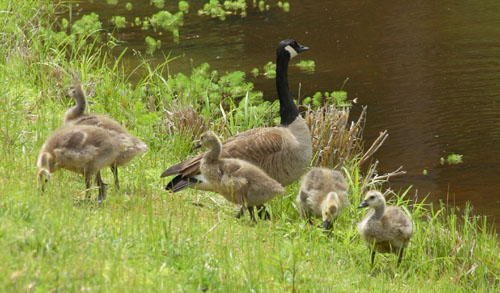 Pay attention to the calls. Birdsong is often considered beautiful, and Disney hasn’t helped to maintain accuracy – most songs are territorial, the result of males staking their claim to an area and making this clear to any interlopers. In the late winter to early spring, it can also serve to lure females, who may have no call at all. If you hear an “answering” call, it’s far more likely to be another male claiming nearby territory. Parent birds may have quiet calls to remind the fledglings to stay within earshot, and alarm calls that tell them to remain motionless. And fledglings have calls to beg for food, usually accompanied by displays such as raised crests and flapping wings, that they will continue for a while after leaving the nest (they will often appear quite anxious that the free meals have gotten few and far between.)
Pay attention to the calls. Birdsong is often considered beautiful, and Disney hasn’t helped to maintain accuracy – most songs are territorial, the result of males staking their claim to an area and making this clear to any interlopers. In the late winter to early spring, it can also serve to lure females, who may have no call at all. If you hear an “answering” call, it’s far more likely to be another male claiming nearby territory. Parent birds may have quiet calls to remind the fledglings to stay within earshot, and alarm calls that tell them to remain motionless. And fledglings have calls to beg for food, usually accompanied by displays such as raised crests and flapping wings, that they will continue for a while after leaving the nest (they will often appear quite anxious that the free meals have gotten few and far between.)
Plumage. The coloration of males, females, and juveniles is usually different within the same species, so pay attention to these details from your identification sources. In addition, quite often there is a different breeding plumage for males in the spring, brighter and more flamboyant. This little fact is an interesting illustration of evolved traits, since more noticeable birds are more likely to attract predators, but the brilliant plumage is also an indication of health to prospective mates, and has been selected for over the generations. So having breeding plumage helps reproduction, but losing it for the remainder of the year, after it serves its purpose, influences survival. Both of these are key factors in selection.
Nestlings and fledglings. These are the terms for immature birds still confined to the nest, and in the process of growing in their flight feathers and learning to fly, respectively. They receive more attention than all other aspects, partially because of folklore, partially because of a simple little trait. First off, you can most certainly pick up a baby bird that’s fallen from the nest and return it – the idea that the mother will abandon it is total horse hockey. Most birds can’t smell at all, and the feeding instinct is so strong that species like cuckoos reproduce by laying their eggs in the nests of other species, letting them raise the young as their own. Nests that are damaged or too far out of reach can be duplicated by a strawberry basket with bedding of toilet paper, placed as close as possible to the original – the parents will frequently accept this just ducky (sorry.) But naturally, handling should only be done as necessary. Later on, many people get concerned when they find birds that cannot fly, almost always in the spring, but fledglings do not leave the nest with these specialized skills completely under control. So they hop around and flutter in people’s yards, gaining concern because they’re cute little birds, but this is normal behavior (the birds I mean) and should be ignored, or at the very least observed without interference unless absolutely necessary. The parents are almost always around and doing some limited feeding, but the incentive has to be there to convince the kid to be on their own. Yes, they’re more vulnerable to predators at this stage, and that’s nature – without a certain level of attrition, we’d be overrun with birds.
Rehabilitation and feather collecting. The idea that raising baby birds is easy (all it takes is bread!) is a common one, but completely and utterly wrong. Not only is the diet specialized, but the housing needs to be adequate and the chance of imprinting or habituating a bird to people, and not the birds it should be hanging out with, are very high. Even giving water presents aspiration hazards – baby birds do not drink. Not to mention that all migratory birds, which is as close to “all birds” as matters, are protected under the Federal Migratory Bird Act. In other words, unless you’re a state and federally licensed rehabilitator, don’t do it. You are not a special exemption, so get over yourself. Contact your local Fish & Wildlife representative, they’ll have access to rehabilitators in your area. The same Act makes it illegal to collect feathers too, regardless of how and where they were obtained. There was likely a good reason for this, but it strikes me as unnecessary overkill, seeing that birds molt their feathers constantly, so obtaining them is as easy as walking in the woods and presents no harm whatsoever to birds. Nevertheless, you are in violation of Federal laws if you’re keeping feathers without specialized permits, and this does include schools and nature presenters (in fact, those are the only circumstances where I’ve seen the law actually enforced.)
Travel. I mentioned above that the typical idea of birdwatching encourages travel to other areas, and that this isn’t necessary in the slightest – almost anywhere that someone lives will have plenty of bird activity. But there’s nothing wrong with going to areas where the activity is higher and the species less familiar. I’ve mentioned places like the Venice Audubon Society Rookery, and Wakodahatchee Wetlands, and Pinckney Island – kindly note that you’re not limited to the southeastern US, these are just places I’m intimately familiar with. There are key spots along migration routes that offer plentiful viewing opportunities at certain times of the year, and ideal nesting areas. There are also semi-captive areas like rehab and study centers that offer closer approaches to habituated birds while still in natural habitats – behavior within such places may not be what you’d see in “the wild,” but will still demonstrate territorial and flock dynamics. You should never feel obligated to travel to see something interesting from avian species, but it doesn’t hurt, either.
So, with all of that out of the way, go out and do some birdwatching! I’m willing to bet that careful observation will produce something new and interesting to you within the first session or two, and as you get familiar with the behaviors and individuals, you’ll begin to understand the stories taking place all around us every day. I admit that I might be biased, but nature is really cool and well worth the attention.

* Notes about binoculars and spotting scopes: These are items that venture into the realm of esoteric specifications and peculiar terms, so I’ll do a little to clarify some of them, with some explanations of how they work as well.
All binoculars are listed with a specific term, like “10×50” – this basically means “magnification” and “field of view,” but the latter also indicates light-gathering ability. The first term is easiest, basically telling you how much closer something seems, and the higher the number the more useful it is, in most cases. Higher magnification also reduces the ability to focus on closer subjects, so there’s such a thing as going overboard – a 20x set of binoculars may be of virtually no use in your backyard since they may not be able to focus inside of ten or fifteen meters.
The field of view helps in watching behavior and following a moving subject – it’s a little like looking through a short or a long tube of the same diameter. A long tube makes your view very narrow and finding subjects can be much harder, so it helps to have something more like a cone – that’s what a higher field of view provides. But there’s another useful trait, and to understand this I have to illustrate something about optical properties.
Light strikes any object and bounces off in all directions – we know this because we can move a step to the right and still see it ;-). Lenses (and telescopic mirrors too) work by gathering this light from across a certain field of view and refocusing it back down to a point. Instead of only seeing light traveling directly towards us, we see the light slightly to either side as well, concentrated back into a single stream. The broader the field of view (the larger the primary lens surface,) the more light is gathered, so binoculars and spotting scopes can often make something look even brighter than our eyes can make out. Even more interesting, they can often see “through” grasses and fences between us and the focused subject by capturing the light that goes past on either side and bending it back to our eyes. The closer the grass/fence, the more it blurs out.
Good binoculars have diopter correction, which is one eyepiece that can be slightly adjusted in magnification. The lenses in our two eyes are often different strengths, and this becomes very noticeable with binoculars, so having one side that can be adjusted to compensate can make a much clearer view. To use this, you cover the side with the diopter and focus tightly on a subject with the other side (do not close one eye – this induces squinting which changes how our eyes focus.) Then, cover the opposite side and use the diopter, without changing the focus of the binoculars, to get a sharp image on that side. In some cases, you may need to do this differently for close or distant subjects.
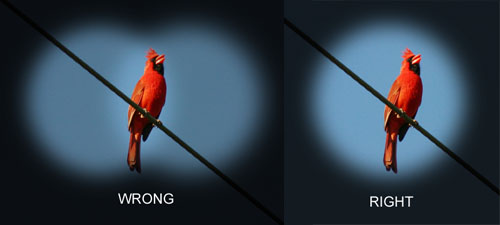 By the way, binoculars work much better if the sides are adjusted properly to your eye width. You know the thing you see in movies every time someone is “looking” through binoculars, where the image becomes two connected circles? This is exactly wrong – properly adjusted, binocular view should be one circle, so if you have overlapping fuzzy circles offset to the sides, the halves are not aligned to your eyes properly.
By the way, binoculars work much better if the sides are adjusted properly to your eye width. You know the thing you see in movies every time someone is “looking” through binoculars, where the image becomes two connected circles? This is exactly wrong – properly adjusted, binocular view should be one circle, so if you have overlapping fuzzy circles offset to the sides, the halves are not aligned to your eyes properly.
Two other terms can be seen with quality binoculars and spotting scopes: these are eyepoint and exit pupil. ‘Eyepoint’ refers to how far away from the eyepiece lens you can be to get the best view – this makes a huge difference if you wear glasses, which force your eye further away, so you often want a high eyepoint eyepiece (the same holds for camera viewfinders.) ‘Exit pupil’ refers to the size of the opening at the eyepiece, or more specifically, how narrow the range of focused light that’s coming through it. A smaller exit pupil means that your eye must be lined up very well at the eyepiece, or you cannot see properly. With glasses, eyepoint and exit pupil can combine to make the image next to impossible to see, seeming to magnify every movement you make and dodge away from you, especially if both the scope and your head are not rock steady (which can rule out trying to track a moving subject.)
Exit pupil is also why spotting scopes can not be converted to camera use very well. The lenses are made to produce only a tiny image, much smaller than the recording medium of film or digital, and attempting to convert this image much larger results in spreading the light far too thin (really, this is the way it works) and darkening the image extensively. It’s unfortunate, but there is (at least some) reason why telephoto lenses are so expensive.
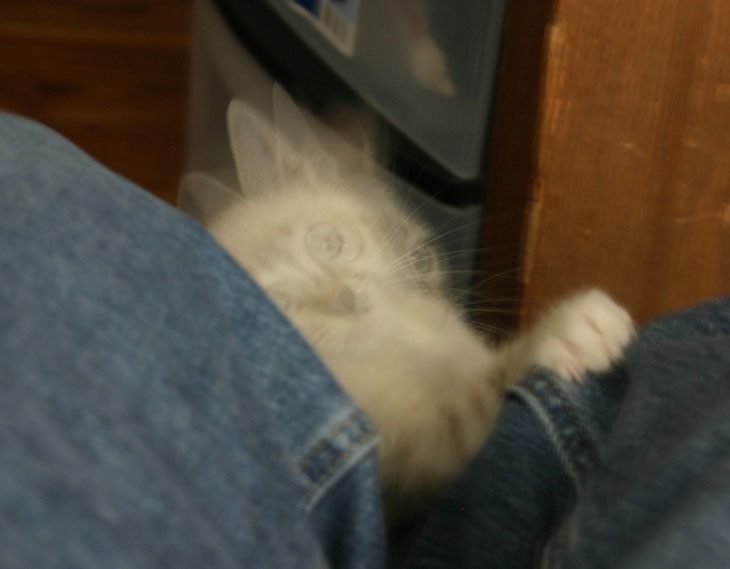
 Earlier today, I decided to play hardball, and sat at my computer with the roast beef and made them come to me. Only Cali and Marley accepted this, but both were coaxed into my lap and received some petting between snacks. The weather has turned a bit chilly recently, a blessing in that I was wearing jeans, the first time I’ve not been in shorts since March; this gave them something to climb, which I’m hoping they get out of when they gain confidence, and will simply jump up when seeking attention. Cali soon lost interest once I put the food away, but Marley liked the petting and began to feel comfortable, so much that when I inadvertently spooked him from my lap, he returned a moment later, then began a quick game of tail chasing. He tried a brief game of “Hang From The Knee and Bite The Denim,” something one of my previous cats used to do on the arm of the couch – I refer to it as a squirrel-killing routine, simply because they appear to like hanging upright and biting the hell out of something. Marley then explored the computer desk a little, but came back and actually began playing with my fingers. He even looked up at me and meowed for attention, the first time I’ve heard him make noise other than during Mortal Komcat. And as I type, he and the flame-point just thundered across the room to my feet, oblivious to this looming human presence. They’re coming along just fine.
Earlier today, I decided to play hardball, and sat at my computer with the roast beef and made them come to me. Only Cali and Marley accepted this, but both were coaxed into my lap and received some petting between snacks. The weather has turned a bit chilly recently, a blessing in that I was wearing jeans, the first time I’ve not been in shorts since March; this gave them something to climb, which I’m hoping they get out of when they gain confidence, and will simply jump up when seeking attention. Cali soon lost interest once I put the food away, but Marley liked the petting and began to feel comfortable, so much that when I inadvertently spooked him from my lap, he returned a moment later, then began a quick game of tail chasing. He tried a brief game of “Hang From The Knee and Bite The Denim,” something one of my previous cats used to do on the arm of the couch – I refer to it as a squirrel-killing routine, simply because they appear to like hanging upright and biting the hell out of something. Marley then explored the computer desk a little, but came back and actually began playing with my fingers. He even looked up at me and meowed for attention, the first time I’ve heard him make noise other than during Mortal Komcat. And as I type, he and the flame-point just thundered across the room to my feet, oblivious to this looming human presence. They’re coming along just fine.





















































 Binoculars or spotting scope: (From Low to High) There’s a reason I list both priorities. Overall, something that let’s you see more at a greater distance helps tremendously and is highly recommended. The question is, what is adequate? Good binoculars get expensive, but spotting scopes are even worse. Good examples of either are typically bulky and heavy by nature, and carrying them around with you is a pain. The best observations are made when you can see the birds nearby and tell what their activities are, especially when you can see interactions, so observing at significant distances hampers this – this is one of the differences between adding a bird to a list and becoming familiar with the species’ behavior. At the least, a lightweight set of binoculars is useful, something that you don’t mind carrying all day, but with more power, of course, comes more distance capabilities. I’ll have some more details on scopes
Binoculars or spotting scope: (From Low to High) There’s a reason I list both priorities. Overall, something that let’s you see more at a greater distance helps tremendously and is highly recommended. The question is, what is adequate? Good binoculars get expensive, but spotting scopes are even worse. Good examples of either are typically bulky and heavy by nature, and carrying them around with you is a pain. The best observations are made when you can see the birds nearby and tell what their activities are, especially when you can see interactions, so observing at significant distances hampers this – this is one of the differences between adding a bird to a list and becoming familiar with the species’ behavior. At the least, a lightweight set of binoculars is useful, something that you don’t mind carrying all day, but with more power, of course, comes more distance capabilities. I’ll have some more details on scopes  What about feeders? There’s a lot of folklore about feeders – some accurate, some not so much. Putting up feeders does not interfere with avian habits, especially migratory behavior, in any significant way, any more than planted crops do. Birds find food where they are able, but migration is a drive that they follow regardless. However, the regular presence of birds does increase the chances that some predator will notice this, such as neighborhood cats, bird-eating raptors, and snakes. This is part of natural behavior too – the rat snake is not better or worse than the black-capped chickadee. As I found out with a potent virus a few years ago, however, bird feeders can contribute to the spread of such illnesses because they encourage shared space and food. It’s hard to say if any good or bad point outweighs the others, so use them as you see fit.
What about feeders? There’s a lot of folklore about feeders – some accurate, some not so much. Putting up feeders does not interfere with avian habits, especially migratory behavior, in any significant way, any more than planted crops do. Birds find food where they are able, but migration is a drive that they follow regardless. However, the regular presence of birds does increase the chances that some predator will notice this, such as neighborhood cats, bird-eating raptors, and snakes. This is part of natural behavior too – the rat snake is not better or worse than the black-capped chickadee. As I found out with a potent virus a few years ago, however, bird feeders can contribute to the spread of such illnesses because they encourage shared space and food. It’s hard to say if any good or bad point outweighs the others, so use them as you see fit. Pay attention to the calls. Birdsong is often considered beautiful, and Disney hasn’t helped to maintain accuracy – most songs are territorial, the result of males staking their claim to an area and making this clear to any interlopers. In the late winter to early spring, it can also serve to lure females, who may have no call at all. If you hear an “answering” call, it’s far more likely to be another male claiming nearby territory. Parent birds may have quiet calls to remind the fledglings to stay within earshot, and alarm calls that tell them to remain motionless. And fledglings have calls to beg for food, usually accompanied by displays such as raised crests and flapping wings, that they will continue for a while after leaving the nest (they will often appear quite anxious that the free meals have gotten few and far between.)
Pay attention to the calls. Birdsong is often considered beautiful, and Disney hasn’t helped to maintain accuracy – most songs are territorial, the result of males staking their claim to an area and making this clear to any interlopers. In the late winter to early spring, it can also serve to lure females, who may have no call at all. If you hear an “answering” call, it’s far more likely to be another male claiming nearby territory. Parent birds may have quiet calls to remind the fledglings to stay within earshot, and alarm calls that tell them to remain motionless. And fledglings have calls to beg for food, usually accompanied by displays such as raised crests and flapping wings, that they will continue for a while after leaving the nest (they will often appear quite anxious that the free meals have gotten few and far between.)
 By the way, binoculars work much better if the sides are adjusted properly to your eye width. You know the thing you see in movies every time someone is “looking” through binoculars, where the image becomes two connected circles? This is exactly wrong – properly adjusted, binocular view should be one circle, so if you have overlapping fuzzy circles offset to the sides, the halves are not aligned to your eyes properly.
By the way, binoculars work much better if the sides are adjusted properly to your eye width. You know the thing you see in movies every time someone is “looking” through binoculars, where the image becomes two connected circles? This is exactly wrong – properly adjusted, binocular view should be one circle, so if you have overlapping fuzzy circles offset to the sides, the halves are not aligned to your eyes properly. 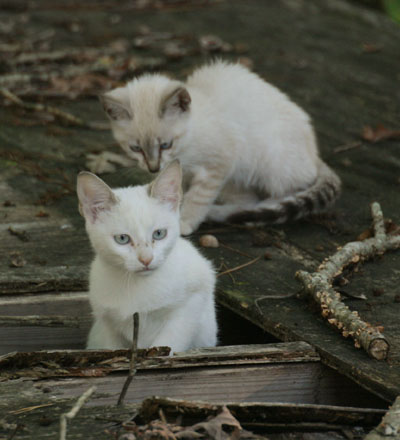 I told you I would probably be back to let you know how it was going with the kittens, and I should have been back sooner, because a lot has happened since the last post. Let me ‘splain… no, there is too much. Let me sum up.
I told you I would probably be back to let you know how it was going with the kittens, and I should have been back sooner, because a lot has happened since the last post. Let me ‘splain… no, there is too much. Let me sum up.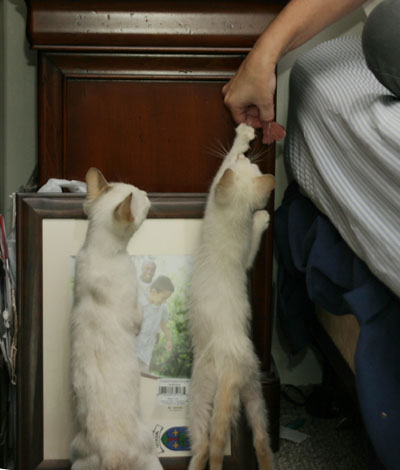 At this point, The Girlfriend decided we should go ahead and trap them indoors at our first opportunity, since the neighborhood has a few too many hazards for little kittens out on their own, so I rigged the back door with a long string so I could close it from a distance, and over the next couple of evenings caught all four during their ventures inside. Since they’re still somewhat feral, this caused a bit of panic, and they secreted themselves in various crannies within the house, giving little indication that they were present at all. Now, as I type this it’s late on Wednesday evening, the 14th, but this will post on Thursday morning, so adjust accordingly. But after dinner this evening, The Grilfriend spotted one of the kittens sneaking around in the bedroom, so we fetched the roast beef lunchmeat and began trying to coax them out. This worked even better than expected, as can be seen from the photo – the calitabby and the flame point took very little time at all to learn how to take snacks from our hands, with the cali actually asking for more audibly. The flame point, less polite, would often snag The Girlfriend’s hand to keep the treats from escaping. As can also be seen here to some degree, the calitabby is noticeably bigger than the flame point, and indeed all three of the others – she appears almost to be older, though this seems exceptionally odd. The likelihood of four kittens from two litters, all Siamese mixes, appearing together at once without a mother, is rather slim.
At this point, The Girlfriend decided we should go ahead and trap them indoors at our first opportunity, since the neighborhood has a few too many hazards for little kittens out on their own, so I rigged the back door with a long string so I could close it from a distance, and over the next couple of evenings caught all four during their ventures inside. Since they’re still somewhat feral, this caused a bit of panic, and they secreted themselves in various crannies within the house, giving little indication that they were present at all. Now, as I type this it’s late on Wednesday evening, the 14th, but this will post on Thursday morning, so adjust accordingly. But after dinner this evening, The Grilfriend spotted one of the kittens sneaking around in the bedroom, so we fetched the roast beef lunchmeat and began trying to coax them out. This worked even better than expected, as can be seen from the photo – the calitabby and the flame point took very little time at all to learn how to take snacks from our hands, with the cali actually asking for more audibly. The flame point, less polite, would often snag The Girlfriend’s hand to keep the treats from escaping. As can also be seen here to some degree, the calitabby is noticeably bigger than the flame point, and indeed all three of the others – she appears almost to be older, though this seems exceptionally odd. The likelihood of four kittens from two litters, all Siamese mixes, appearing together at once without a mother, is rather slim. My computer sits in the corner of the living room, and as I unloaded the first images to begin this post, the calitabby and a lynx point both sat nearby and watched me, allowing me to talk to them without being very antsy at all. They’ve been both investigating and playing within the living room, so The Girlfriend and I feel that getting these critters tamed down as housecats isn’t going to pose much difficulty in the slightest. I just paused right there (it’s almost live-blogging!) and got out some toys, and it didn’t take a lot of effort to get the lynx point totally spazzed out. It’s been very amusing, and I regret having no decent way of obtaining video at the moment, or you’d be seeing more than still images.
My computer sits in the corner of the living room, and as I unloaded the first images to begin this post, the calitabby and a lynx point both sat nearby and watched me, allowing me to talk to them without being very antsy at all. They’ve been both investigating and playing within the living room, so The Girlfriend and I feel that getting these critters tamed down as housecats isn’t going to pose much difficulty in the slightest. I just paused right there (it’s almost live-blogging!) and got out some toys, and it didn’t take a lot of effort to get the lynx point totally spazzed out. It’s been very amusing, and I regret having no decent way of obtaining video at the moment, or you’d be seeing more than still images.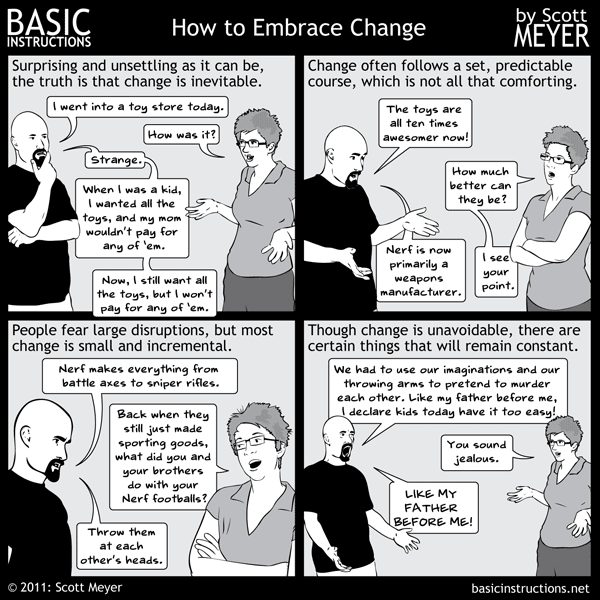
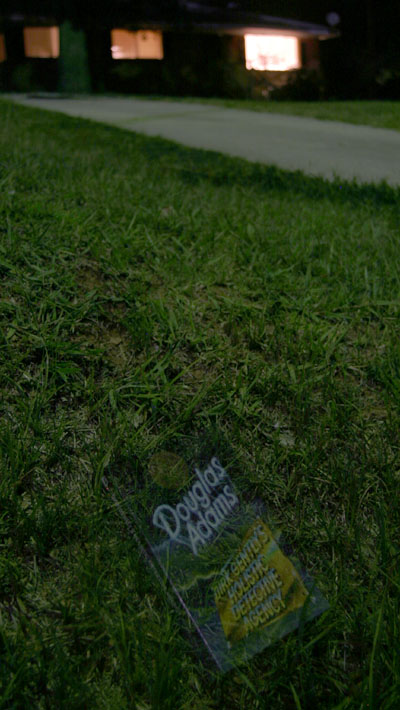

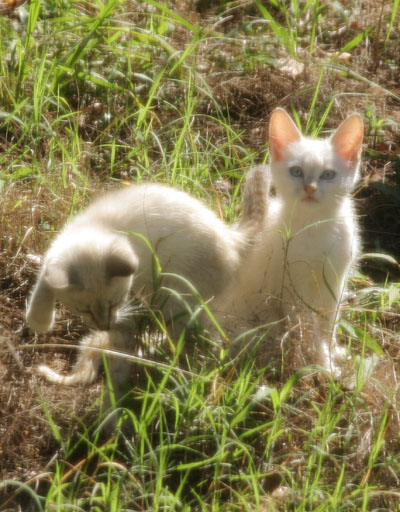
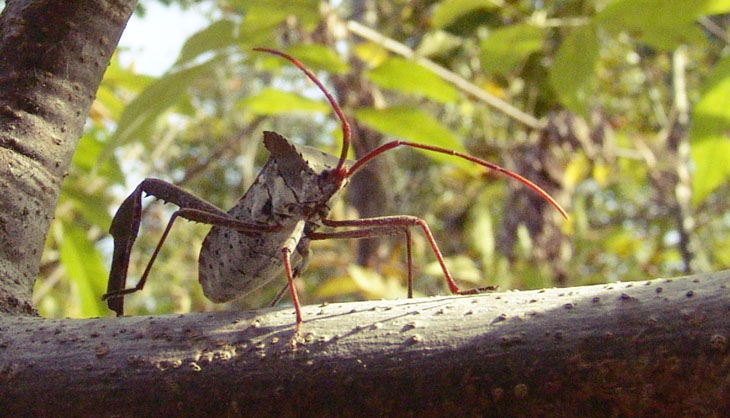
 Be meticulous: Note date, time, weather conditions, plant conditions, and so on. Has it been a long time since rain? Does certain behavior seem to occur only at certain times? Pay attention, and see if any patterns emerge. But…
Be meticulous: Note date, time, weather conditions, plant conditions, and so on. Has it been a long time since rain? Does certain behavior seem to occur only at certain times? Pay attention, and see if any patterns emerge. But…